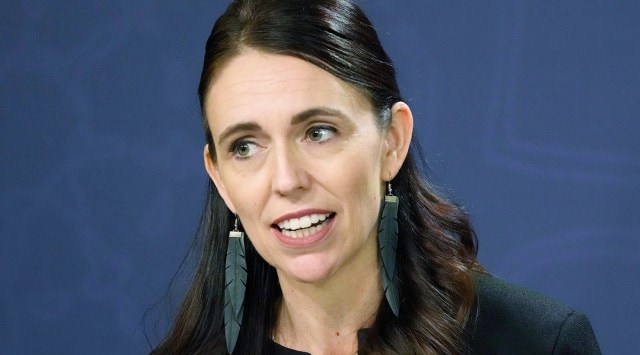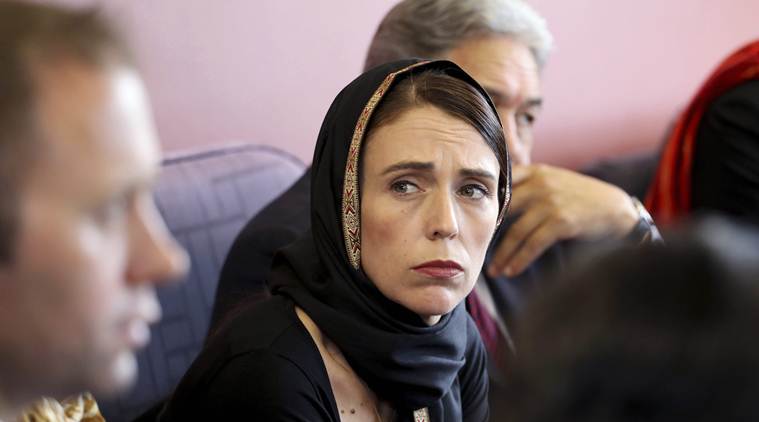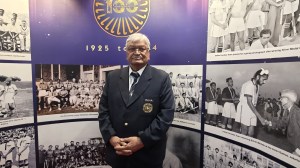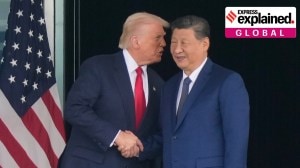Stay updated with the latest - Click here to follow us on Instagram
6 key moments from Jacinda Ardern’s tenure as New Zealand Prime Minister
Jacinda Ardern's tenure at the top post was, in many ways, historic. Here are a few significant moments from Ardern's career that set her apart from her peers in the global political scene.
 New Zealand Prime Minister Jacinda Ardern has announced her resignation as New Zealand prime minister. (AP, file)
New Zealand Prime Minister Jacinda Ardern has announced her resignation as New Zealand prime minister. (AP, file) Six years after she first took office as the Prime Minister of New Zealand, Jacinda Ardern announced Thursday that she will be stepping down from the post. “I am leaving because with such a privileged role comes responsibility – the responsibility to know when you are the right person to lead, and also, when you are not. I know what this job takes, and I know that I no longer have enough in the tank to do it justice,” she said in a press meet in Wellington.
Ardern’s tenure at the top post was, in many ways, historic. When she was sworn in as the PM at the age of 37, she became the youngest woman worldwide to be the head of government. A year later, she became one of the few elected heads of government in the world to give birth in office, second only to Pakistan’s Benazir Bhutto, who gave birth to her daughter Bakhtawar Bhutto Zardari in 1990.
During her term in office, she was widely appreciated for her progressive politics and feminist choices, and emerged as a “celebrity politician”, frequently appearing on magazine covers and lists of top world politicians. Though her strict handling of the Covid-19 pandemic initially garnered praise and support from New Zealanders and the world alike, her popularity at home had nose-dived in recent days due to the rising cost of living, inflation, a surge in social inequality and the increasing popularity of right-wing political ideas.
Here are a few significant moments from Ardern’s career that set her apart from her peers in the global political scene.
Jacinda Ardern’s swift reaction to Christchurch terror attack
One of the most memorable moments in Ardern’s tenure came two years after she first took charge. On March 2019, a 28-year-old gunman opened fire in two mosques in Christchurch, killing 51 people and injuring 49 others. Within hours, the Prime Minister issued a statement on national television, deploring the “extremist views” that led to the attack. “It is clear that this can only be described as a terrorist attack,” she said.
 In this photo released by New Zealand Prime Minister’s Office, Prime Minister Jacinda Ardern meets representatives of the Muslim community on March 16, 2019, at the Canterbury Refugee Centre in Christchurch, New Zealand. (AP/PTI)
In this photo released by New Zealand Prime Minister’s Office, Prime Minister Jacinda Ardern meets representatives of the Muslim community on March 16, 2019, at the Canterbury Refugee Centre in Christchurch, New Zealand. (AP/PTI)
The PM’s unequivocal condemnation of the attacks gained international attention, providing a positive contrast to alleged racist and Islamophobic views expressed by several world leaders, including then-US president Donald Trump. A day later, she visited the families of the victims.
A photograph of the Christian Prime Minister looking distraught and wearing a black scarf on her head as a mark of respect was hailed as “an image of hope”.
Ardern also promised to bring in stricter gun laws, and fulfilled that promise by bringing in gun reforms banning military-style semi-automatics, and declaring in Parliament: “Owning a firearm is a privilege, not a right.”
Jacinda Ardern: A world leader and a mother
Three months after she gave birth, Ardern took her baby daughter to the United Nations assembly meeting in September 2018. “Ms. Neve Te Aroha, New Zealand First Baby” — read the baby’s UN diplomatic photo ID. Ardern and her partner Clarke Gayford were seen attending meetings, and the Prime Minister spoke at the Mandela Peace Summit as little Neva napped at her side.
Because everyone on twitter’s been asking to see Neve’s UN id, staff here whipped one up.
I wish I could have captured the startled look on a Japanese delegation inside UN yesterday who walked into a meeting room in the middle of a nappy change.
Great yarn for her 21st. pic.twitter.com/838BI96VYX— Clarke Gayford (@NZClarke) September 24, 2018
Ardern’s move received support from several quarters, with former US ambassador to UN Samantha Power tweeting, “I cannot stress how much the @UN — and the governments that comprise it — need this.”
I cannot stress how much the @UN – and the governments that comprise it – need this. https://t.co/d9NHkms96R
— Samantha Power (@SamanthaJPower) September 25, 2018
The PM also mentioned her family while sharing her decision not to stand for re-election. “I am looking forward to spending time with my family again – arguably, they are the ones that have sacrificed the most out of all of us. And so to Neve, mum is looking forward to being there when you start school this year. And to Clarke, let’s finally get married,” she said. The couple had set a date to get married before their plans were postponed due to the Covid-19 pandemic.
 New Zealand Prime Minister Jacinda Ardern, right, hugs her fiancee Clark Gayford after announcing her resignation at a press conference in Napier, New Zealand, Jan. 19, 2023. (AP/PTI)
New Zealand Prime Minister Jacinda Ardern, right, hugs her fiancee Clark Gayford after announcing her resignation at a press conference in Napier, New Zealand, Jan. 19, 2023. (AP/PTI)
Ardern’s handling of Covid-19 pandemic
During the Covid-19 pandemic, as confusion and misinformation ruled the roost, especially in the initial days, Ardern chose to go ahead with a mitigation approach rooted in science and in tandem with the local community. Her government was among the first in the world to impose a national lockdown, issue strict isolation mandates, and shut off international borders. Placing public health and safety at the forefront of its Covid-strategy, the New Zealand government put forth a transparent and united front, especially in the initial days of the pandemic.
Suze Wilson, a lecturer at Massey University in New Zealand, wrote in 2020 that Ardern communicated the nation’s Covid strategy with empathy, addressing and responding to extensive questions from the press while several world leaders, including then-British Prime Minister Boris Johnson, “largely sought compliance.”
When Ardern represented Māori culture at Buckingham Palace
Months after she took office, a pregnant Ardern caused a stir when she walked through the halls of England’s Buckingham Palace wearing a traditional Māori cloak lined with feathers of native birds. The handwoven cloak is steeped in history and is worn by high-standing members of New Zealand’s indigenous Maori community.
An amazing image of leadership in 2018. 😍
New Zealand’s feminist Prime Minister Jacinda Ardern, wearing a korowai (Māori cloak), attending a Commonwealth meeting in the post-empire colonised world. pic.twitter.com/vSV7YB7niE— Mariam Parwaiz (@MariamParwaiz) April 20, 2018
Worn as a symbol of power and respect, the cloak that Ardern wore was on loan to her from London’s Māori club, Ngāti Rānana, as per news reports. Mark Sykes, who oversees Māori special collections at New Zealand’s national museum, told The Guardian that the PM’s choice of attire was a message of inclusivity. “I think it shows how she is portraying herself as a leader of Māori, of all of New Zealand, of everyone. It made me feel proud. She wore it well. She wore it so well,” Sykes said.
Incidentally, Ardern’s daughter’s name is a tribute to Maori culture. Te Aroha “encompass all the names suggested by Maori around and also reflected where Ms Ardern had grown up,” wrote Radio New Zealand in a report.
Launching New Zealand’s first Wellbeing Budget
New Zealand unveiled its first ‘Wellbeing Budget’ in 2019 under Ardern’s leadership. The budget laid emphasis on mental health, the well-being of children, providing support to the native Māori and Pasifika populations, building a productive nation, and transforming the economy. Touted as one of the first such projects in the world, it was hailed as an attempt to measure success and value in more than just economic terms. “Success is making New Zealand both a great place to make a living, and a great place to make a life,” finance minister Grant Robertson told the country’s Parliament in his budget speech.
It was, however, criticised as a performative gesture by many. Arthur Grimes, an economist-turned-professor of well-being and public policy, told The Guardian the budget was “marketing as opposed to substance”. He said that since the move came at a time when the governments of other developed countries like Britain and the US seem to not be prioritising the well-being of the public, it was hailed as a novel and grand gesture.
Australia-based Local Government Information Unit noted that the budget is written such that it is difficult to measure its impact. “The well-being budget can be seen as a significant step forward by reframing the budgetary process so that bids must specifically address well-being priorities and bring together all of the agencies which need to be involved. It falls short of being fit for purpose because of its disconnect from communities and hence the inability to directly address community well-being in ways which recognise that each community has its own unique set of conditions, priorities, and needs,” it said.
An earthquake? Just another day in office
On a lighter note, Ardern’s unruffled demeanour as she navigated earthquakes (yes, multiple times) while on camera has received much praise.
Jacinda Ardern keeping her cool as an earthquake rattled the North Island around 10 minutes ago. @1NewsNZ pic.twitter.com/TSfiplDtMb
— Andrew Macfarlane (@andrewmacfnz) October 21, 2021
In a viral video of the press meet, Ardern is seen briefing the media on New Zealand’s post-Covid plans when the lectern suddenly starts shaking in the middle of a reporter’s question. The Prime Minister looked to the side for a minute, before replying with a small smile: “Ah, sorry, a slight distraction – would you mind repeating that question?”
This wasn’t Ardern’s only experience navigating an earthquake with cameras pointed at her. In May 2020, a 5.8 magnitude earthquake hit Wellington as the PM was participating in a television interview. “We’re just having a bit of an earthquake here, Ryan,” Ardern told the interviewer with a grin. “Quite a decent shake here, if you see things moving behind me,” she said, to which the interviewer replied, “Alright, has it stopped?”
Ardern replied after a few seconds that the shaking has stopped and that she feels safe enough to continue the interview as she was at a structurally sound place, and not under any hanging lights or other hazardous materials.





- 01
- 02
- 03
- 04
- 05


























